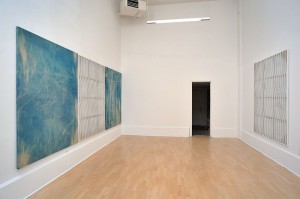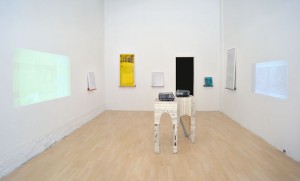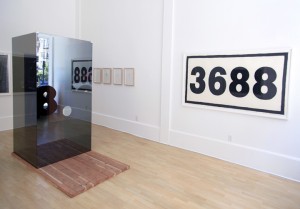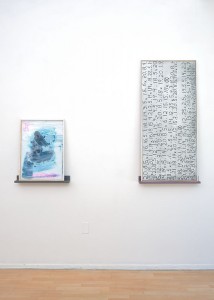Jessica Silverman is the owner and director of Jessica Silverman Gallery, located at 804 Sutter Street (between Jones and Leavenworth) in San Francisco. Currently installed is Dashiell Manley’s exhibition of double-sided objects and animated videos whose unique aesthetics and conceptual complexity echoes the entirety of Silverman’s roster.
AH: Do you consider yourself as a gallerist, curator or a dealer?
JS: When I first opened the gallery, I saw myself as a dealer and as a curator. But as the gallery has grown, my role has evolved and I have had to readjust my position. At the moment when people ask me for a title I say, owner and director.
That being said, I curated our recent group show Erogenous Zones. During installation of this and other shows I am committed to resolving curatorial aspects of the exhibition. I see my role as continuously shifting from working with the artist but also taking care of the collectors, the museums and the institutions. They are in the end equally as responsible for our growth as are the artists.
AH: How long have you had a gallery? I know that this is the second location.
JS: This is the second location. When I moved to San Francisco, I was in the Curatorial Practice program at CCA. I opened the gallery at a basement location in the Dogpatch during the second year of my MA. I was there for one year. I had initially thought that I would do something like an artist-run space but we formalized the gallery and moved in 2008 to our current location.
AH: What brought you to this career? Were you an artist previously to running a space or being in the curatorial field?
JS: I had a studio practice for a number of years and did at one time consider myself an artist. I went to Otis College and studied painting and photography but during my time there, I felt much more engaged in the conversations I was having with other artists about their work than my own personal practice. It really felt like my practice was about the way I was engaging with other people.
I started thinking about the position of the dealer, the position of the curator and then the position of all of these artists coming out of school. I quickly turned my studio into a gallery and called it Studio 228. I put up exhibitions with artists in graduate programs at neighboring art schools. I showed people graduating from CalArts, UCLA, and an artist doing a residency from Israel. I tried to bring artists into the Otis cultures that were practicing in other schools but still in the California area. That was kind of my first foray as an artist turning into a dealer/curator.
AH: What do you look for in an artist or artist’s practice? How do you go about finding artists? Do you do studio visits?
JS: I do a tremendous amount of studio visits. I go to open studios. I go to grad shows. I have dialogues with people. One artist we now represent I first saw on a blog and quickly flew out to see their work in person. A collector in New York suggested an artist we offered an exhibition to and now represent. More and more, that’s happening, because you bond with collectors who really love your program and they start to understand what you’re looking for. It can be shocking how on point they can be in what you are interested in.
AH: What do you feel your responsibility is to the artists you pick up? Versus people you would put in a group show.
JS: I care so much about the artists and feel hugely responsible for their careers. My main responsibility is to provide a context that they feel excited about, interested in and trust. They have to look at the program as a whole and feel comfortable being a part of it. I think a lot about that as I build the program and as we grow. I provide international, national and local contexts through art fairs and relationships we build with other dealers.
AH: How do fairs fit into your program? This is something that’s new to me and I think to an extent it’s fairly fresh in the art world. What part do you think they play in the art world in general? I get the feeling that the best galleries are increasingly fair focused.
JS: Being a dealer in San Francisco I wanted to make sure that we positioned ourselves in an international dialogue and in order to do that you have to do fairs. I really love them and think about the booths as exhibitions. Fairs are very commercially driven and sales driven but they are also incredible opportunities for a large group of curators, dealers and collectors to see work all at once. Last year we did 8 art fairs.
AH: Wow.
JS: I think this year we’ll do close to 6 or 7. We’ve already taken on a new one in Chicago in September. Last year we did Dallas and Cologne, which were new fairs as well as NADA New York.
AH: I think that’s the fear for someone like me. I’m just learning about fairs, which is sort of naïve but true, and how the work can provide a context for itself and be read not as these autonomous things that are bought and traded but as art.
JS: It’s an important thing to try to wrap your head around and we have to just keep trying different fairs and see what works with our program. They’re not all slam-dunks.
AH: You’re in San Francisco, which is not known for necessarily adventurous exhibition making especially within a commercial format. Why are you here? What is your relationship to the Bay Area?
JS: Before I went to CCA, I had been working for an art advisor in LA and I really thought that I would move back to LA and open a gallery there but decided to give SF a chance.
I’ve really taken to San Francisco and I feel like it’s really taken to me. I like working here. I love my collectors here and I love that I’m close to LA. Staring the gallery in San Francisco allowed me the chance to grow without being under constant scrutiny. If you look at New York, it’s hard for a younger dealer to hold onto a hot artist. In San Francisco, for the most part, there’s a slower build and I feel like that allows me to develop careers in a much more thorough manner before they skyrocket. Being in a small city, you also have more access to the curators here. We have very close relationships with the CCA Wattis, Berkeley At Museum and SFMOMA .
AH: I think I once saw a Fluxus piece in a group show of yours. So some of those things come from your family’s collection?
JS: Yes, my grandparents have now donated their collection to MOMA but when they had it in Detroit they would lend me things. We’ve had Yoko Ono, Robert Smithson works on paper, Nam June Paik, La Monte Young books, etc.
I have always been really interested in printed material and in the coming years I would like to do more publications with our artists. We just did a publication for one of our artists, Hugh Scott-Douglas with his Berlin dealer and Mousse magazine.
AH: There’s the perception that gallerists and dealers guide their artists as to what would make the most sense commercially or within the space of the gallery – do you have that sort of relationship? Is there like a push and pull between what the artist might be making incidentally within the studio versus what would make sense within the gallery?
JS: This is something that actually goes back to the art fair culture. The fair is an inherently commercial venue and so on some level the dealer and the artist both feel equally compelled to put out work that has commercial viability. That being said, we also want to make strong and impactful booth presentations. I work closely with our artists to make sure that they are comfortable with whatever work is going to the art fair so their practice feels properly represented.
AH: You have a group show with some regularity at your gallery. What role do you feel those play?
JS: We try to do about one to two a year. In the past two years we have had Food For Thought curated by Sabrina Buell, which looked at the relationship between food and art. We had Forms and Inflections a group show that explored the possibilities of fixed information structures. Most recently we hosted Erogenous Zones. The group exhibitions provide a platform for artists that I am interested in. They give us a platform to see if it is an artist we could see offering a solo show to.
AH: Do you have any advice to a young curator or would-be dealer?
JS: Try to keep in mind the historical references that contemporary artists are aligning themselves with right now. I believe strongly in building relationships between different histories. As I move forward I like to look back at more historic moments.
AH: Is that something that you actively do – put artists in contact with some sort of reference?
JS: Yes, I send links all the time of things that they need to be aware of. I also try to find group show opportunities that contextualize the work, alongside other artists that were making work that has a similar resonance from the ‘40s or ‘50s, 60’s, 70s etc. Those are the dialogues I’m interested in and I try to make sure that the artists are really aware of the whole spectrum of information.






 RSS
RSS
